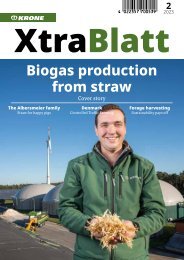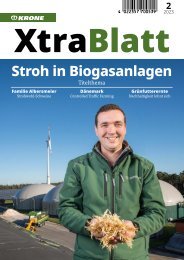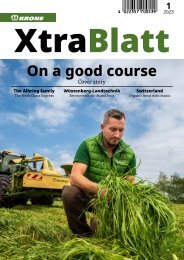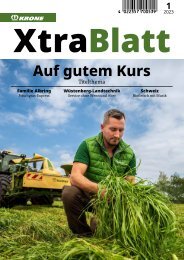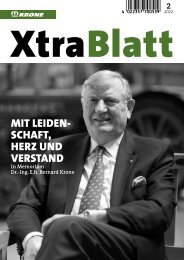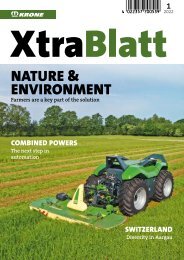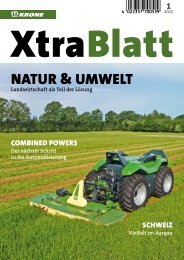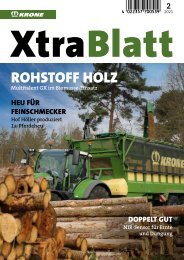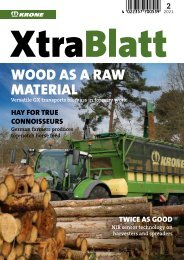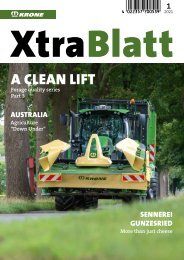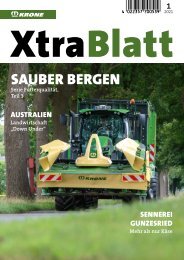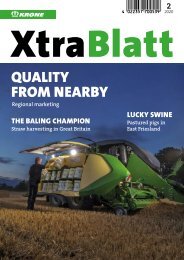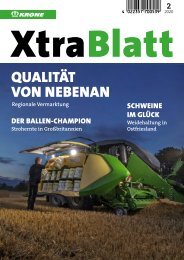XtraBlatt Issue 02-2017
Create successful ePaper yourself
Turn your PDF publications into a flip-book with our unique Google optimized e-Paper software.
The machinery sharing society<br />
“Grass-1” includes two truck-mounted<br />
feed mixer wagons.<br />
around 60 TMRs in operation.” And: “The<br />
subsidisation for purchase of large scale<br />
machinery varies from year to year and<br />
this has led to us selling in one year 20 BiG<br />
Ms and 20 BiG Xs. In another year, however,<br />
sales are maybe only three or four of<br />
each. Thus, sales planning is not easy.”<br />
The farmer-members of Grass-1, incidentally,<br />
together run around 750 cows<br />
milked twice a day through carousel or<br />
herringbone parlours. Robot systems are<br />
not common. The rations for each farm<br />
are mixed in the Grass-1 yard and delivered<br />
via truck-mounted mixer. Also supplied<br />
with this feed are a few customers<br />
that are not members of Grass-1.<br />
The baler-wrapper combination for maize is built by Takakita and allows silage to be wrapped and<br />
deposited directly on farms that have no clamps or silos.<br />
quest for this is already written out. Up<br />
to 50% of the purchase price is subsidised<br />
in Japan because the government wants<br />
to further professionalise dairying and<br />
aid efficiency, and thus increase milk<br />
production. The farm’s own feed mixing<br />
plant together with large-capacity feed<br />
mix wagons were subsidised, the office<br />
building and the silage clamps, however,<br />
were not. In total, around 6 m euros has<br />
been invested in machinery and buildings<br />
since 2015. “The first machinery ring, TMR<br />
for short, was founded in 2001,” recalls<br />
Martin Seggering, who has been working<br />
in the Japanese market, along with several<br />
other regions, for some years. “In the<br />
last five or six years, however, ring numbers<br />
have increased massively, Japan’s<br />
government investing a lot of money in<br />
order to reduce dependency on food imports.<br />
After all, the average milk production<br />
performance, thanks to TMR, has increased<br />
within around 15 years from 7000<br />
– 8000 l to approx. 10,000 l/cow and<br />
year. Above all, this has been due to improved<br />
feed quality and more professionally<br />
conceived and adjusted cow rations.<br />
Nowadays on Hokkaido, there should be<br />
STEEP SLOPES<br />
The Akan TMR, also visited on West Hokkaido,<br />
works with self-propelled machines<br />
from Krone. “We operate three BiG<br />
Xs, types 650 and 700, two working the<br />
whole season through, and one in peak<br />
periods or as substitute machine,” explains<br />
Akan manager Yoshio Masaki. “Akan<br />
belongs to 24 farmers with a total 1500<br />
dairy cows and 760 ha grass plus 260 ha<br />
forage maize.” Contrary to the other<br />
farms we visited, here a pass with the tedder<br />
takes place after the mower. The aim<br />
is to increase dm content from around 25<br />
to some 30%. Here and there, a couple<br />
of wafflers are also used to help dry the<br />
crop. Despite this, special lacto-bacilli<br />
additives are still used with the silage.<br />
According to the manager, the products<br />
are more cost efficient than formic acid.<br />
“At first cut, we harvest around 38 to<br />
40 t/ha, in the second one only some<br />
20 t/ha,” notes Yoshio Masaki. “The<br />
17



